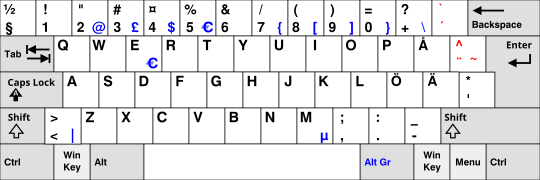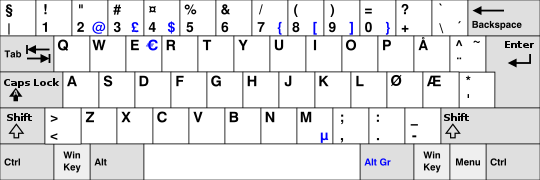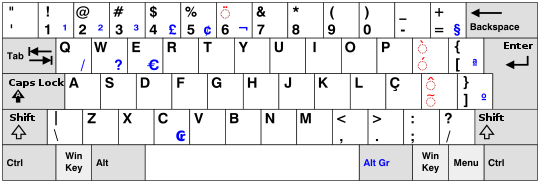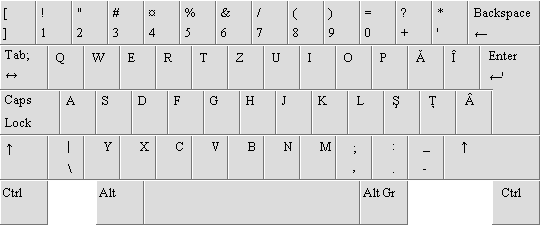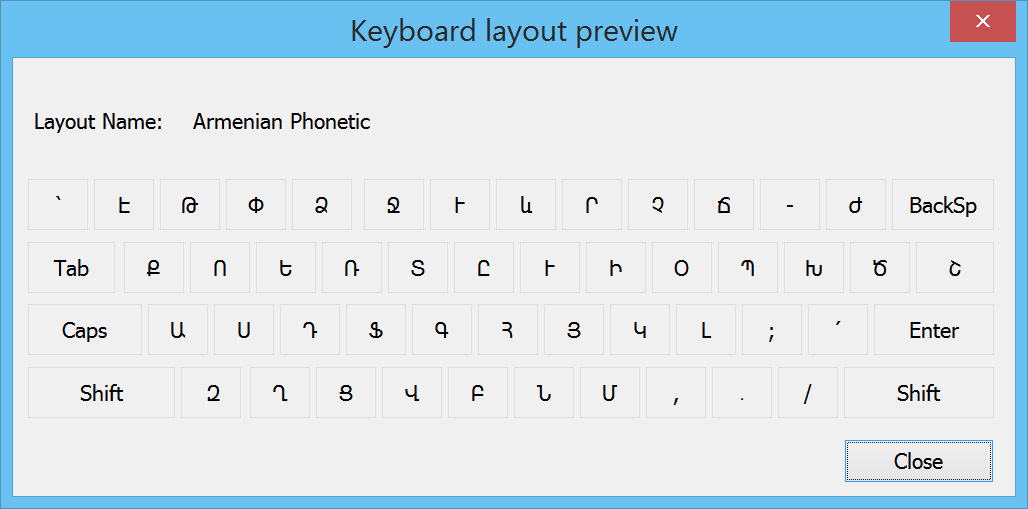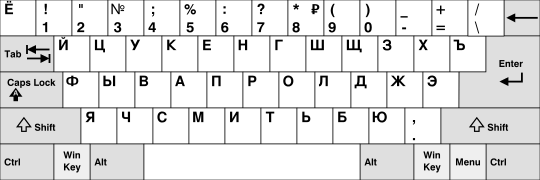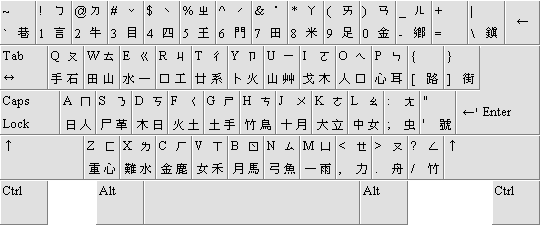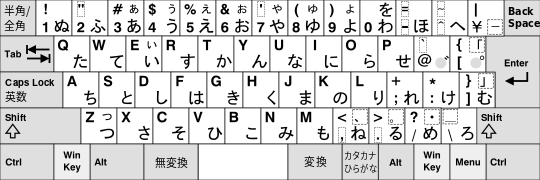Keyboard layout
Computers and other typing devices offer many different keyboard layouts for inputting data in different languages. The standard English keyboard layout is known as QWERTY. Various alternatives to the QWERTY layout have been suggested, many claiming advantages such as higher typing speeds. One of the most common alternatives is the Dvorak Simplified Keyboard.

Keyboard structure
Keys labelled with only a capital letter can type both small and capital letters. To type the symbol at the top left of a key, the shift key, often labelled "↑", is used. To type the symbol at the bottom right of a key, the AltGr key is used. (Further symbols are available on the smaller keyboards of laptop computers, which require further keystroke combinations.)
The standard keyboard structure also includes the control, alternative, and function keys. These keys are commonly known as modifier keys.
Dead key
A dead key produces no output when it is pressed, but modifies the output of the next key pressed after it.
Many languages include characters additional to the standard upper and lower case 26-letter alphabet, such as accented characters, that do not easily fit onto a standard English-language keyboard (UK, US or other varieties). Typing accented characters is made easier by using the dead key feature. When a dead key is pressed, nothing happens on the screen, but then pressing the character to be accented makes the desired accented character appear on the screen. For example, typing the acute accent dead key followed by the letter a gives á. To type a diacritical mark on its own, it needs to be followed by a space.
In the Mac OS, dead keys are accessed with the option (alt) key as follows:
| ´ | option-e |
| ` | option-` |
| ¨ | option-u |
| ^ | option-i |
| ~ | option-n |
which is then followed by the letter the accent is intended for. For example, the keypresses option-e e results in the é character. In Mac OS X, pressing one of these key combinations creates the accent and hi-lights it, then produces the finalized character when a vowel is pressed, or simply leaves the accent if a consonant is pressed.
Note on keyboard layouts
The following layouts assume that the physical locations of the keys are the same as on a US 102-key PC/AT keyboard. In practice, keyboards from other countries may have keys in slightly different locations. However, on a US 102-key PC/AT keyboard with an operating system configured for a non-English language, the keys will be placed as follows. "Dead keys" (see above) appear in red. Characters accessed using the AltGr key appear at the bottom right of the corresponding key, or in some images in blue.
Keyboard layouts for Roman script
Although there are a large number of different keyboard layouts used for different languages written in Roman script, most of these layouts are quite similar. They can be divided into three main families according to where the Q, A, Z, M, and Y keys are placed on the keyboard. These are usually named after the first six letters.
While the core of the keyboard, the alphabetic section, remains fairly constant, and the numbers from 1-9 are almost invariably on the top row, keyboards differ vastly in:
- the placement of punctuation characters,
- which punctuation characters are included,
- whether numbers are accessible directly or in a shift-state,
- the presence and placement of accent deadkeys and accented characters.
QWERTY
By far the most widespread, the only one not confined to a particular geographical area. Keys like "enter" and "caps lock" have not been translated to the language of the keyboard in question.
Canadian French
linux configuration code: ca_enhanced
- In many versions, the guillemets key is moved to the other end of the character line, right of "É", making both shift keys the same size.
Canadian Multilingual Standard
United States keyboards are also used in Canada.
Danish
Finnish/Swedish
Italian
Note:
- braces (right above square brackets and shown in purple) are given with both AltGr and Shift pressed.
Norwegian
Portuguese (Portugal)
Portuguese (Brazil)
Spanish
UK and Ireland
The United Kingdom and Ireland keyboard layout is similar to the United States layout. Hong Kong uses US and Chinese (Traditional) keyboards rather than UK and Ireland ones. See the article British and American keyboards for details. See also Technical standards in colonial Hong Kong.
Note:
- the key to the immediate left of numeral 1 (backtick, `) gives (logical NOT, ¬) when shifted (instead of ~) and with AltGr either
- vertical bar | (OS/2's UK166 keyboard layout, Linux UK keyboard layout),
or - broken vertical bar ¦ (Microsoft Windows' UK/Ireland keyboard layout);
- vertical bar | (OS/2's UK166 keyboard layout, Linux UK keyboard layout),
- the key to the immediate left of Z gives, when shifted, either
- broken vertical bar ¦ (OS/2's UK166 keyboard layout),
or - vertical bar | (Microsoft Windows' UK/Ireland keyboard layout and Linux UK/Ireland keyboard layout).
- broken vertical bar ¦ (OS/2's UK166 keyboard layout),
US
The US keyboard layout does not use AltGr or any dead keys, and thus offers no way of inputting any sort of diacritic or accent; this makes it unsuitable for all but a handful of languages. On the other hand, US keyboard layout is widely used by programmers.
U.S. keyboards are used not only in the United States, but also in most English-speaking countries, e.g. Canada, Australia, and New Zealand. In the United Kingdom, UK keyboards are used. See British and American keyboards for details.
US-International
The US keyboard layout can be configured to type accents efficiently. This is known as the US-International layout. Using the same layout as the US keyboard, accented characters can be typed by pressing the appropriate accent key, then the letter on the keyboard in its unaccented form. Accent keys share the same key as ', `, ", ^ and ~.
Accent keys are activated by pressing it (without holding it), and next pressing the letter that requires an accent. After the two strokes, the single accented character would appear on the screen. Note that only vowels can have accents in this way. If one wishes to use the normal single quotation mark, caret and so on, one would press the accent key followed by the spacebar. Accented characters can be typed with the following combinations:
- ' then letter (é)
- ` then letter (è)
- " then letter (ë)
- ^ then letter (ê)
- ~ then letter (ñ)
Thus, in this sense, the keys ', `, ", ^ and ~ are dead keys when first depressed, then become normal keys functioning in the same way as keys on the US keyboard if the spacebar is pressed.
There are also alternative US-International formats, whereby modifier keys such as shift and alt are used, and the placement of the accented characters are different from the placement of their unaccented counterparts.
QWERTZ
The QWERTZ layout is fairly widely used in Germany and much of Central Europe. The main difference between it and QWERTY is that Y and Z are swapped, and most special characters such as brackets are replaced by German special characters.
Hungary
Germany and Austria (but not Switzerland)
Poland
Most typewriters use a QWERTZ keyboard with Polish accentuated letters accessed directly, while practically all computers (except custom-made, e.g., in public sector) use standard US layout (commonly called Polish programmers layout, in Polish: polski programisty) with Polish letters accessed through AltGr (AltGr-Z giving "Ż" and AltGr-X giving "Ź").
Swiss German, Swiss French, Liechtenstein, Luxembourg
Luxembourg does not have a keyboard layout of its own. Public education uses the Swiss-French keyboard, while the banking sector prefers the Belgian layout. Other places use either, or the US layout.
Romanian in Romania and Moldova
The above layout is not widespread — the American QWERTY layout is the most common in these two countries.
AZERTY
The AZERTY layout is used in France, Belgium and some neighbouring countries. It differs from the QWERTY layout thus:
- A and Q are swapped
- Z and W are swapped
- M is moved from the right of N to the right of L [where colon/semicolon is on a US keyboard]
- The digits 0 to 9 are on the same keys, but to be typed the shift key must be pressed. The unshifted positions are used for accented characters.
The French AZERTY keyboard also has special characters used in the French language, such as ç, à é, è, and other characters such as &, " ,' ,§, , all located under the numbers.
Some French people use the Canadian Multilingual standard keyboard. The Portuguese (Portugal) keyboard layout may also be preferred, as it provides all French accents (acute, grave, tréma, tilde, circumflex, cedilla, and also quotation marks «») and its dead-letter option for all the accent keys allow for easy input of all the possibilities in French and most other languages(áàäãâéèëêíìïîóòöõôúùüû). Ç is, however, a separate key, as can be seen above.
French
Belgian
The Belgian AZERTY was developed from the French AZERTY but some adaptions were made in the 1980s. All letters remain the same as on the French keyboard, but some signs (? ! @ - _ + = §) are on different locations.
File:French (Belgian) keyboard.jpg
QZERTY
The QZERTY layout is used mostly, if not exclusively, in Italy, where it is very common on typewriters. Computer keyboards are usually QWERTY, although non-alphanumeric characters vary.
- Z and W are swapped
- M is moved from the right of N to the right of L, as in AZERTY
Dvorak and others
There are also keyboard layouts that do not resemble QWERTY/QWERTZ/AZERTY very closely, if at all. Best-known among these is the Dvorak Simplified Keyboard layout (named after its inventor, not the key order), which reduces finger movement and is claimed by some proponents to offer higher typing speed along with ergonomic benefits. There are also single-handed Dvorak layouts (one each for left-handed and right-handed typing), as well as adaptations for languages other than English. For software developers there is also the Programmer Dvorak layout which has been optimized for typing source code.
Some languages use the Roman script but with non-QWERTY-based keyboard layouts, such as Latvian and Turkish (the majority of Turkish keyboards are QWERTY, though the "Turkish-F keyboard layout"[1] is older and said to be better suited to the language).
Besides Dvorak, other keyboard layouts include:
QWERTY-based
Chorded Keyboards
A syllabic chord keyboard is a keyboard with three sets of keys that are used to type in a single syllable with one (combined) keystroke. Other chorded keyboards are also in use (often for specialized applications), such as the Stenotype.
Turkish
The Turkish language uses the Roman alphabet, and a dedicated keyboard layout was designed in 1955 by İhsan Yener. During its design the Turkish Language Academy (TDK) investigated letter frequencies in Turkish, using this statistical basis to design the Turkish-F keyboard. It provides a balanced distribution of typing effort between the hands - 49% for the left hand and 51% for the right. Turkey has won several world championships with this keyboard layout [citation needed]. The Turkish-F keyboard layout is the only official Turkish keyboard layout.
Besides the Turkish-F keyboard the QWERTY keyboard is increasingly widely used on computers in Turkey.
QWERTY- and Dvorak-based
- Qwerak (2002)
Dvorak-based
Original
- Kiwi (custom layout evolver) (2006)
- Writer's Keyboard Layout (2006)
- Michael Capewell's evolved layout (2005)
- NEO layout Template:De icon [4] (2004)
- Plum [5] (2003)
- Arensito (2001)
- Peter Klausler's evolved layout (2002)
- Maltron layout [6] (1977)
- HCESAR (1937)
- Roy E. Hoke's layout (U.S. patent 1,506,426, 1924)
- Sidney W. Rowell's layout (U.S. patent 943,466, 1909)
- DHIATENSOR layout (1893)
- The QWERF layout reduces finger movements 28% over regular QWERTY.
Keyboard layouts for non-Roman alphabetic scripts
Some keyboard layouts for non-Roman alphabetic scripts, most notably the Greek layout, are based on the QWERTY layout, in that glyphs are assigned as far as possible to keys that bear similar-sounding or appearing glyphs in QWERTY. This saves learning time for those familiar with QWERTY.
This is not a general rule, and many non-Roman keyboard layouts have been invented from scratch.
Most non-Roman keyboard layouts have the capacity to be used to input Roman letters as well as the script of the language, for example, when typing in URLs or names. This may be done through a special key on the keyboard devoted to this task, or through some special combination of keys, or through software programs that do not interact with the keyboard much.
Arabic
Armenian
Greek
Hebrew
Russian
People who do not have a Cyrillic keyboard sometimes use a phonetic (transliterated) layout where 'А' is obtained by pressing 'A', Russian 'Б' by pressing 'B', 'Д' by pressing 'D', 'О' by pressing 'O' etc. Also there was some alternative (e.g. 'ЯВЕРТЫ') keyboard layouts extinct by now. See also Russian keyboard: standard and phonetic.
Bulgarian
The Bulgarian BDS layout.
The Bulgarian Phonetic layout. Although not standard, this layout is widespread because of its similarity to the QWERTY layout. It is a Phonetic not Transliteration layout, and produces cyrillic symbols.
Both layouts are in widespread use.
Presently a formal procedure for the introduction of a standard Bulgarian Phonetic layout is underway. The new layout differs from the above one in the case of few Cyrillic letters, and has the Euro sign added too.
Transliteration using Roman script is used only in informal electronic written communication, mainly because of a long history of compatibility issues with different encodings, history of lack of native OS support and user laziness.
Devanāgarī
Thai
Khmer
East Asian languages
Chinese, Japanese, and Korean require special input methods, often abbreviated to CJK IMEs, due to the thousands of possible characters in these languages. Various methods have been invented to fit all these possibilities into a normal QWERTY keyboard, so East Asian keyboards are essentially the same as those in other countries. However, their input methods are considerably more complex, without one-to-one mappings between keys and characters.
In general, first the range of possibilities is narrowed down (most often by entering the desired character's pronunciation), then, if there remains more than one possibility, selecting the desired ideogram either by typing the number before the character, or using a graphical menu to select it. The computer assists the typist by using heuristics to guess which character is most likely desired. Although this may sound clumsy, East Asian input methods are today sufficiently sophisticated that, for both beginners and experts, typing in these languages is only slightly slower than typing English.
In Japanese, the QWERTY-based JIS keyboard layout is used, and the pronunciation of each character is entered using Hepburn romanization or Kunrei-shiki romanization. There are several kana-based typing methods. See also Japanese language and computers.
Chinese has the most complex and varied input methods. Characters can be entered by pronunciation (like Japanese and Korean) or by structure. Most of the structural methods are the most difficult to learn, but they are extremely fast for experienced typists, as they do away with the need for selecting characters from a menu. For a detailed treatment, see Chinese input methods for computers.
There exist a variety of other, slower ways a character may be entered. If the pronunciation of a character is not known, the selection can be narrowed down by giving its component shapes, radicals, and stroke count. Also, many input systems include a "drawing pad" permitting "handwriting" of a character using a mouse. Finally, if the computer does not have CJK software installed, it may be possible to enter a character directly through its encoding number (e.g. Unicode).
In contrast to Chinese and Japanese, Korean is typed the same way as Western languages. There are two major kinds of keyboard layouts: dubeolsik and sebeolsik. Dubeolsik, based on the QWERTY keyboard, is more commonly used. While Korean consonants and vowels (jamo) are grouped together into syllabic characters when written, the language itself is actually alphabetical, and therefore typing in Korean is quite simple for someone who understands the Korean alphabet Hangul. Each jamo is assigned to a single key. As the user types letters, the computer automatically groups them into syllabic characters. Given a sequence of jamo, there is only one unambiguous way letters can be validy grouped into syllables, so this grouping is done seamlessly by the computer, with the result that Korean can be typed in the same way as English or any other alphabetical language.
Chinese
Chinese (traditional)
Computers in the Republic of China (Taiwan) often use Zhuyin (bopomofo) style keyboards (US keyboards with bopomofo labels), many also with Cangjie method key labels, as Cangjie is the standard method for speed-typing in Traditional Chinese. The bopomofo style keyboards are in lexicographical order, top-to-bottom left-to-right.
The codes of three input methods are typically printed on the Chinese (traditional) keyboard: Zhuyin (upper right); Cangjie (lower left); and Dayi (lower right).
This is an example with Cangjie (blue) and Bopomofo/Zhuyin (red).
In Hong Kong, both Chinese (Traditional) and US keyboards are found. Japanese keyboards are occasionally found, but UK keyboards are rare.
See also British and American keyboards, Technical standards in colonial Hong Kong
A Chinese (Traditional) keyboard has a US layout with Chinese input method labels printed on the keys. These keyboards can be used for Roman characters, provided that US keyboard layout is selected in the operating system.
Chinese (simpified)
Keyboards used in the mainland of the People's Republic of China typically use a US keyboard and input Chinese characters using Hanyu pinyin, which represents the sounds of Chinese characters using Latin letters.
See the section on Chinese languages above, and also Chinese input methods for computers.
Hangul (for Korean)
Dubeolsik
Dubeolsik (두벌식) is the most common Hangul keyboard layout in use in South Korea. Pressing the Ha/En(한/영) key once switches between Hangul as shown, and English. There is another key to the left of the space bar for Hanja input. If using a standard 104-key keyboard, the right Alt key will become the Ha/En key, and the right Ctrl key will become the Hanja key. Alternate keyboard styles exist, such as those used by IBM mainframes, but these are rarely used. Consonants occupy the left side of the layout, while vowels are on the right.
Sebeolsik 390
Sebeolsik 390 (세벌식 390) was released in 1990, hence its name. It is based on Dr. Kong's earlier work. This layout is notable for its compatibility with the QWERTY layout; all QWERTY symbols are available in Hangul mode. Numbers are placed in three rows. Syllable-initial consonants are on the right (shown green in the picture), and syllable-final consonants and consonant clusters are on the left (shown red). Some consonant clusters are not printed on the keyboard; the user has to press multiple consonant keys to input some consonant clusters, unlike Sebeolsik Final. It is more ergonomic than the dubeolsik, but is not in wide use.
Sebeolsik Final
Sebeolsik Final (세벌식 최종) is another Hangul keyboard layout in use in South Korea. Numbers are placed on two rows. Syllable-initial consonants are on the right, and syllable-final consonants and consonant clusters are on the left. Vowels are in the middle. All consonant clusters are available on the keyboard, unlike the Sebeolsik 390 which does not include all of them. It is more ergonomic than the dubeolsik, but is not in wide use.
Sebeolsik Noshift
Sebeolsik Noshift is a variant of sebeolsik which can be used without pressing the shift key.
Japanese
Usually the JIS keyboard is used. Some people type Hiragana directly, but most people prefer typing Latin alphabets, which are automatically converted to Hiragana. In both cases, the Alt+Zen/Han key combination is used to switch on input method editor. Some people prefer the US layout, in which case Alt+` does the role, or Cmd-Space for Macs.
See the section on East Asian languages above, also Japanese language and computers and Japanese input methods.
See also
- Language code
- Chinese input methods for computers
- Japanese language and computers
- Technical standards in colonial Hong Kong
- British and American keyboards
- Unicode
External links
- On-Screen Windows Keyboard.
- IBM's database of keyboard layouts
- IBM site about keyboard layouts
- Learn2Type.com has free online typing lessons
- Multilingual Windows keyboards in both QWERTY and Dvorak layouts
- Variant Windows keyboards, U.S. and non-U.S.
- Microsoft Keyboard Layout Creator (free)
- Ukelele a Mac OS X Keyboard Layout Editor (free)
- Creating custom keyboard layouts in Linux/UNIX
- PowerTyping - Flash-based Online Typing Tutor for Qwerty and Dvorak
- Gate2Home.com - Onscreen Virtual Keyboard with Multilingual layouts
- JavaScript Virtual Keyboard - Lightweight, zero-configuration script for use on the web (free)
- Esperanto keyboard
- Apple Powerbook Keyboard Layout
- Diktor Keyboard Layout Template:Ru icon
- 2006 Bulgarian Phonetic Keyboard The new layout developed by Dimitar Skordev, Faculty of Mathematics and Informatics, Sofia University, and Dimitar Dobrev, Institute of Mathematics and Informatics, Bulgarian Academy of Sciences
- Tavultesoft Keyman - Shareware software package with dozens of custom keyboard layouts



